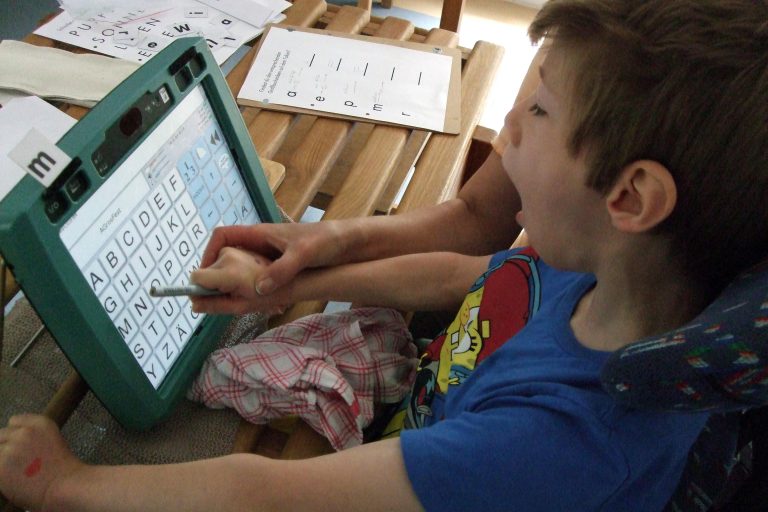What is AAC?
What is AAC? Augmentative alternative communication or AAC refers to the systems and devices that help people with limited verbal skills or who are nonverbal communicate with others.
We all use AAC. Every time you make a thumbs-up sign, scribble a note and pass it to someone, or throw a knowing glance across the room without speaking, you engage in AAC.
However, there has been some confusion over what exactly AAC is all about. In today’s post, we’ll go over the basics of AAC, what it can do, and who benefits from it.
What is the difference between augmentative communication and alternative communication?
AAC is divided into two main forms of communication: augmentative and alternative.
Augmentative communication uses systems/devices to supplement natural speech. For instance, a small portable amplifier can increase speech volume and help those with limited vocal capacity communicate effectively.
Alternative communication uses systems/devices to replace natural speech. A keyboard text-to-speech program, or even something as simple as a communication board, are tools that enable alternative communication. Users of alternative communication devices typically do not have the ability to communicate verbally.
Initially, this field was simply called “augmentative communication.” The term “alternative” was later added to stress that communication devices can either enhance or replace natural speech.
In 1983 the International Society for Augmentative and Alternative Communication was established as the world’s premier organization working to serve the needs of children and adults with complex communication needs.
Members of ISAAC (pretty slick acronym, don’t you think?) include users of AAC, their families, teachers, students, therapists, and researchers from around the world.
What is AAC? In short, AAC is anything that helps anyone communicate effectively.

What is an AAC device?
AAC devices come in all shapes and sizes. Some examples include iPads, speech generating devices (SGD), an eye gaze, communication boards, and picture books.
As you can see, these devices don’t have to be fancy or high-tech. Anything that either supplements speech or helps people communicate nonverbally counts as an AAC device.
Who uses AAC?
Users of AAC may have limited verbal skills, suffer from impairments in the production and comprehension of spoken language, or be totally nonverbal.
People use AAC on either a temporary or long-term basis.
Temporary users are individuals who experience a stroke, traumatic brain injury, ALS, or some other injury or condition. They will use AAC devices until their natural communication methods are healed and restored.
Long-term users are those with congenital disorders or disabilities such as autism, cerebral palsy, or severe childhood apraxia of speech. They may require communication assistance for multiple years or their entire lives.

How do people communicate using AAC?
What is AAC? AAC is generally divided into three categories:
- High-tech: digital technologies such as iPads and computers with text-to-speech software. Amplifiers and devices with pre-recorded messages also fall into this category. High-tech AAC devices are often ‘dynamic’, meaning they can generate different words, phrases, or messages to suit the user’s immediate communication needs.
- Low-tech: picture symbols, drawing tools, communication boards, picture books, etc. Low-tech devices include a limited number of ‘static’ displays that cannot generally be changed.
- No tech: sign language, gestures, facial expressions, body language, and even non-linguistic vocalizations. This kind of AAC has existed since the dawn of time and is still an essential tool for helping people with limited verbal skills communicate.
The fundamental goal of AAC is to enhance users’ communication abilities and expand their vocabularies. Any tool or method that does this is part of AAC.
What can an AAC user say?
Absolutely anything! A key aspect of AAC is access to the necessary vocabulary. A speech therapist may teach or program devices based on what types of vocabulary their patient needs. AAC vocabulary is divided into core and fringe.
Core vocabulary: everyday nouns, pronouns, verbs, and question words. Because these words and terms are used daily, high-tech AAC devices will often include shortcuts or autofill features to access these terms easily.
Fringe vocabulary: words applicable to a specific, non-routine activity. When someone watches a football game, they may need sports terminology. When they visit Disneyland, they need to name all the different princesses, heroes, and evil villains. And so on!
If you are interested in learning more, the American Speech-Language-Hearing Association is a fantastic resource: Augmentative and Alternative Communication: A Glossary: American Speech Language Hearing Association (ASHA).
If you have more questions about AAC devices or pediatric therapy services more generally, please do not hesitate to reach out. Our team would be happy to answer your questions. Complete our Get Started form and someone from our team will reach out to you.




